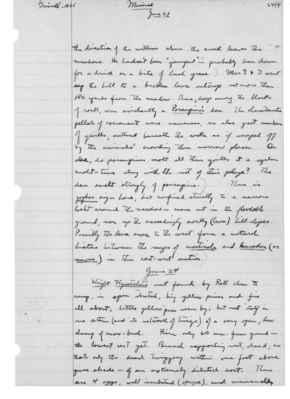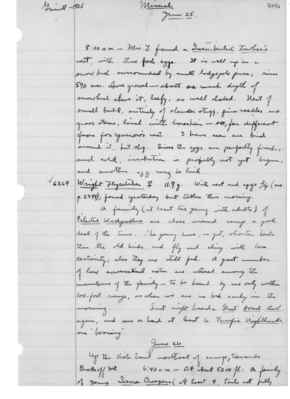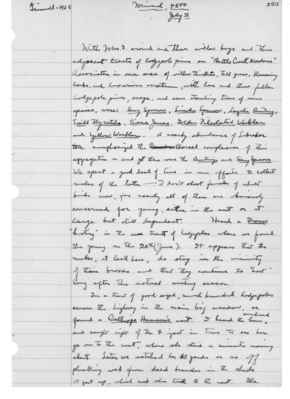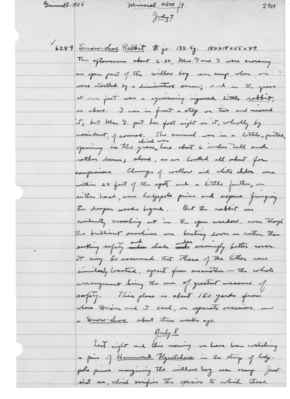Pages That Mention grass
1925: Joseph Grinnell's field notes
S2 Page 40
Collector: Grinnell - 1925 Location: Mineral Date: June 23-24 Page Number: 2494
the direction of the willows where the creek leaves the meadows. He hadn't been "jumped" - probably been down for a drink or a bit of lush grass. Mrs. G. & I went up the hill to a broken lava outcrop not more than 150 yards from the meadow. There, deep among the blocks of rock, was evidently a Porcupine's den. The characteristic pellets of excrement were numerous, as also great numbers of quills, scattered beneath the rocks as if scraped off by the animals' crowding the narrow place. Or else, do porcupines molt all their quills at a regular molt-time along with the rest of their pelage? The den smelt strongly of porcupine. There is gopher sign here, but confined strictly to a narrow belt around the meadow - none out in the floodable ground, nor up in the exceedingly rocky (lava) hill-slopes. Possible the lava areas to the west form a natural hiatus between the ranges of monticola and leucodon (or navus) in this east-west section.
June 24 Wright Flycatcher's nest found by Rett close to camp, in open stretch, big yellow pines and firs all about; little yellow pines near by; but nest itself in one stem (and its network of twigs) of a very open, low clump of snow-bush. Rim only 6/0 mm. from ground the lowest nest yet. Branch supporting nest, dead; so that only the dead twiggery within one foot above gives shade - of an extremely diluted sort. There are 4 eggs, well incubated (opaque), and unusually
S2 Page 42
Collector: Grinnell - 1925 Location: Mineral Date: June 25 Page Number: 2496
8:00 a.m. - Mrs. G. found a Green-tailed Towhee's nest, with three fresh eggs. It is well up in a snow bush surrounded by small lodgepole pines; rim 590 mm. above ground - about as much depth of snowbush above it, leafy, so well shaded. Nest of small bulk, entirely of slender stuff, pine needles and grass stems, lined with horsehair - so, far different from fox sparrow's nest. I have seen one bird around it, but shy. Since the eggs are perfectly fresh, and cold, incubation is probably not yet begun, and another egg may be laid.
6264 Wright Flycatcher [female symbol] 11.9 g. With nest and eggs 3/4 (see p. 2494); found yesterday but taken this morning.
A family (at least two young with adults) of Pileated Woodpeckers are close around camp a good deal of the time. The young have, as yet, shorter tails than the old birds, and fly and cling with less certainty; also they are still fed. A great number of low conversational notes are uttered among the members of the family - to be heard by us only within 100-foot range, as when we are in bed early in the morning. Last night heard a Great Horned Owl again, and saw or heard at least 6 Pacific Nighthawks, one "booming".
June 26 Up the Vista Trail northeast of camp, towards Brokeoff Mt. 6:40 a.m. - At about 5200 ft.: A family of young Sierra Creepers (at least 4, tails not fully
S2 Page 55
Collector: Grinnell - 1925 Location: Mineral Date: June 28 Page Number: 2508
poising, motionless, at times against the stiff west wind. Mrs. G. found a family of Golden crowned Kinglets in a group of young firs near camp - adults and 4 young, fully grown. I had a clear view of the two of the young - white line over eye, contrasted against dusky or blackish top of head.
June 29 8 a.m. - Traill Flycatcher's nest: in bog, chiefly grown to willow, but some white alder; located out in jungle, alongside of indistinct deer-trail; overtopped, well shaded, by lush green willow and older foliage; rim 1400 mm. above ground, nest insse^securely supported among cluster of upright small willow stems and emanating leaves. Taken (2/4)*, and [female symbol] parent shot.
Russet-backed Thrushes' nest: in same bog as last; rim 780 mm. above ground; situated in rather low willow clump, with larger (taller) clumps of willow and white alder about separated from one another by openings grown to lush grass and buttercup; a meadow stream runs 20 feet away. The green leafage above and all about the nest effectually conceals the nest until parted. The nest is supported on a slanting willow stem plus adjacent twigs and foliage. Taken (1/4)**, and [female symbol] parent taken; [male symbol] heard singing in vicinity mornings and evenings ever since we have been here. Mrs. G. found this nest. The site is almost directly between those of the two
S2 Page 60
Collector: Grinnell - 1925 Location: Mineral, 4800 Date: July 2 Page Number: 2513
With Mrs. G. around and thru [sic] willow bogs and thru [sic] adjacent tracts of lodgepole pines on "Battle Creek Meadows." Associates in one area of willow thickets, tall grass, blossoming herbs, and luxurious verotrum, with here and there fallen lodgepole pines, snags, and some standing trees of same species, were: Song Sparrow, Lincoln Sparrow, Lazuli Bunting, Traill Flycatcher, Sierra Junco, Golden Pileolated Warbler and Yellow Warbler. A nearby abundance of Labrador tea emphasized the Canadian Boreal complexion of this aggregation - and yet there were the Buntings and Song Sparrows. We spent a good deal of time in our efforts to collect males of the latter - I don't shoot females of adult birds now, for really all of them are obviously concerned for young, either in the nest or at large but still dependent. Heard a Grouse "hooting" in the same tract of lodgepoles where we found the young on the 20th (June). It appears that the males, at least here, do stay in the vicinity of their broods and that they continue to "hoot" long after the actual mating season.
In a tract of good-sized, much branched lodgepoles across the highway in the main big meadow, we found a Calliope Hummer's nest. I heard the hum overhead and caught sight of the female just in time to see her go on to the nest, where she staid a minute moving about. Later we watched her 50 yards or so off plucking web from dead branches in the shade 10 feet up, which web she took to the nest. She
S2 Page 71
Collector: Grinnell - 1925 Location: Mineral, 4800 ft. Date: July 7 Page Number: 2524
6289 Snow-shoe rabbit [male symbol] ju. 132.5 g. 180x18x55x49.
This afternoon about 2:30, Mrs. G and I were crossing an open part of the willow bog near camp, when we were startled by a diminutive stream; and in the grass at our feet was a squirming injured little rabbit, as above. I was in front a step or two and missed it; but Mrs. G. put her foot right on it, wholly by accident, of course The animal was in a little, parted opening in the grass ^which was here about 6 inches tall and rather dense; alone, as we looked all about for companions. Clumps of willow and white alder were within 25 feet of the spot; and a little farther, on either hand (?), were lodgepole pines and aspens fringing the deeper woods beyond. But the rabbit was evidently crouching out in the open meadow, even though the brilliant sunshine was beating down - rather than seeking safety underand shade andunder seemingly better cover. It may be assumed that others of the litter were similarly located, apart from one another - the whole arrangement being the one of greatest measure of safety. This place is about 150 yards from where Dixon and I each, on separate occasions, saw a Snow-shoe about three weeks ago.
July 8 Last night and this morning we have been watching a pair of Hammond Flycatchers in the strips of lodge pole pines margining the willow bog near camp. Just shot one, which verifies the species to which these




